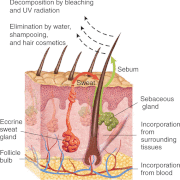Minireview: Hair cortisol: a novel biomarker of hypothalamic-pituitary-adrenocortical activity
- PMID: 22778226
- PMCID: PMC3423616
- DOI: 10.1210/en.2012-1226
Minireview: Hair cortisol: a novel biomarker of hypothalamic-pituitary-adrenocortical activity
Abstract
Activity of the hypothalamic-pituitary-adrenocortical (HPA) axis is commonly assessed by measuring glucocorticoids such as cortisol (CORT). For many years, CORT was obtained primarily from blood plasma or urine, whereas later approaches added saliva and feces for noninvasive monitoring of HPA functioning. Despite the value of all these sample matrices for answering many research questions, they remain limited in the temporal range of assessment. Plasma and saliva are point samples that vary as a function of circadian rhythmicity and are susceptible to confounding by environmental disturbances. Even urine and feces generally assess HPA activity over a period of only 24 h or less. We and others have recently developed and validated methods for measuring the concentration of CORT in the body hair of animals (e.g. rhesus monkeys) and scalp hair of humans. CORT is constantly deposited in the growing hair shaft, as a consequence of which such deposition can serve as a biomarker of integrated HPA activity over weeks and months instead of minutes or hours. Since the advent of this methodological advance, hair CORT has already been used as an index of chronic HPA activity and stress in human clinical and nonclinical populations, in a variety of laboratory-housed and wild-living animal species, and in archival specimens that are many decades or even centuries old. Moreover, because human hair is known to grow at an average rate of about 1 cm/month, several studies suggest that CORT levels in hair segments that differ in proximity to the scalp can, under certain conditions, be used as a retrospective calendar of HPA activity during specific time periods preceding sample collection.
Figures
References
-
- Barroso M, Gallardo E, Vieira DN, López-Rivadulla M, Queiroz JA. 2011. Hair: a complementary source of bioanalytical information in forensic toxicology. Bioanalysis 3:67–79 - PubMed
-
- Bévalot F, Gaillard Y, Lhermitte MA, Pépin G. 2000. Analysis of corticosteroids in hair by liquid chromatography-electrospray ionization mass spectrometry. J Chromatogr B Biomed Sci Appl 740:227–236 - PubMed
-
- Cirimele V, Kintz P, Dumestre V, Goullé JP, Ludes B. 2000. Identification of ten corticosteroids in human hair by liquid chromatography-ionspray mass spectrometry. Forensic Sci Int 107:381–388 - PubMed
-
- Gaillard Y, Vayssette F, Pépin G. 2000. Compared interest between hair analysis and urinalysis in doping control. Results for amphetamines, corticosteroids and anabolic steroids in racing cyclists. Forensic Sci Int 107:361–379 - PubMed
-
- Raul JS, Cirimele V, Ludes B, Kintz P. 2004. Detection of physiological concentrations of cortisol and cortisone in human hair. Clin Biochem 37:1105–1111 - PubMed


